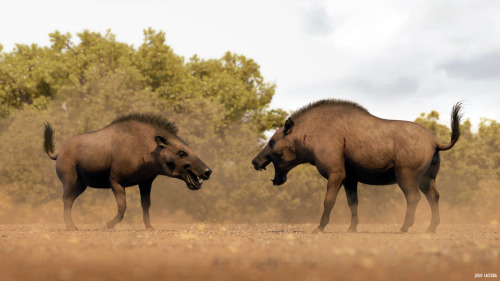#entelodonts
Daeodon – Late Oligocene-Early Miocene (29-19 Ma)
As I said last time we went to Mammal Junction, a lot of mammals from the prehistoric Cenozoic are similar to mammals we have now, or look kind of like a generic mammal. Some of them, though, weren’t. Some were absolutely positively bizarre. Let’s talk about one.
This ugly motherfucker is named Daeodon, and lived in North America during the Paleogene-Neogene divide. Daeodon—and other entelodonts, by extension—is essentially what it looks like. It’s a carnivorous ungulate, or, hoofed mammal. No surprises here, other than the fact it existed. Today, the only ungulates who eat meat are whales1. Ungulates make up most of the large land mammals today, and they’re all big grazers. Daeodon and its cousins, however, were apex predators.
If you’ve seen Walking with Beasts, Daeodon might look familiar to you. A similar animal appears in the third episode, “Land of Giants,” called an “entelodont.” That one lived in central Asia and probably belonged the genus Entelodon. If you’ve seen the documentary, you certainly remember maybe the most gruesome scene in the entire franchise, where a territorial fight between two of them leads to one’s face being fucked right up. Even as a violence-loving kid that one kind of made me shudder.
But even though Walking with tends to sensationalize its animals, that wasn’t really the case this time. They were probably a lot like that. Aggressive, terrifying, and ugly as hell. I wanted to give them a little more fur, though, since I personally don’t believe they were naked like a domestic pig. They’ve been nicknamed “Hell pigs” or “Terminator pigs” and I find it hard to disagree.
They had big-ass heads and powerful jaws with pairs of huge canines and incisors, along with batteries of tough, blunt molars. This mixture of teeth is, weird as it probably sounds, sorta convergent with ours. Sharp front teeth and dull, rounded teeth in the back? These were the teeth of an omnivore. They fed themselves with a mix of scavenging and active hunting, and probably rounded out their diet with roots and tubers, an echo of their relationship with other hooved animals. They’re like a concept for a horror movie character. It’s like Kujo for pigs, I think. I don’t know much about Kujo other than the fact that Stephen King was inebriated when he wrote it and doesn’t even remember doing so.
It’s important to mention that they weren’t actually pigs, although we used to think some of them were. They’re the weird cousin pigs don’t talk about. Paleontologists like to disagree on how closely they were related to pigs and other artiodactyls (even-toed ungulates). I did a lot of digging to see where they might fall, and the general consensus looks like “somewhere around hippos and whales2.”
More about this genus specifically, Daeodon was the largest member of the entelodont family, being a bit taller than the average grown man. I am really glad I don’t live alongside these things. One specimen was originally named Dinohyus, which means “terrible pig.” It’s thought that Daeodon, more than other entelodonts, was mostly a scavenger. It followed other carnivores around and waited for them to kill something, then got in there and screamed at them until they ran away. These were huge animals with mouths full of sharp teeth; it probably wasn’t too hard for them to terrify their fellow meatboys.
Daeodon is also interesting because it’s kind of a tangle in the entelodont family tree. First of all: entelodonts are found pretty evenly in Eurasia and North America. So, there’s a cousin of Daeodon who lived in the same region of North America, a few million years earlier, called Archaeotherium. I actually almost talked about that one today instead. The obvious conclusion there is that Daeodon is descended from Archaeotherium, right? And that was the idea for a long time. But, looking closer, we found that it looks more like its cousins on the other side of the Pacific. It might be descended from an immigrant population of entelodonts who crossed over from Asia. Wack.
This leads to some questions, like, were the entelodonts in America just worse at being entelodonts? Did these guys come over the land bridge and just outcompete them? It’s really hard to say, since most animals aren’t fossilized and it’s totally possible they coexisted with native entelodonts and we just haven’t found them. Of course, they might also just be descended from American entelodonts and happened to develop convergent traits with their cousins across the pond. Listen, this science is a total disaster sometimes. We’re doing the best we can with piles of bones we find in the dirt.
So, yeah, that’s Daeodon, the murder “pig.” The Cenozoic is still full of surprises for us. A lot of the animals that didn’t survive to modern times are absolutely buckwild, and if this one doesn’t prove that, I’ll need to try harder. I mean, even if it does convince you, there’s still some weird shit out there that I’d love to cover. And that’s why I’m here!
P.S. If you haven’t seen Walking with Beasts, I highly recommend it. It’s the passion project of the Walking with team, and probably the most accurate installment of the three.
1Whales evolved from ungulates, and so are considered members of that group even though they have no gotdamn legs
2If any of my readers know more about the relationship between entelodonts and other artiodactyls, please let me know. I’m not certain that I’m right on this and I’d love clarification
Post link


